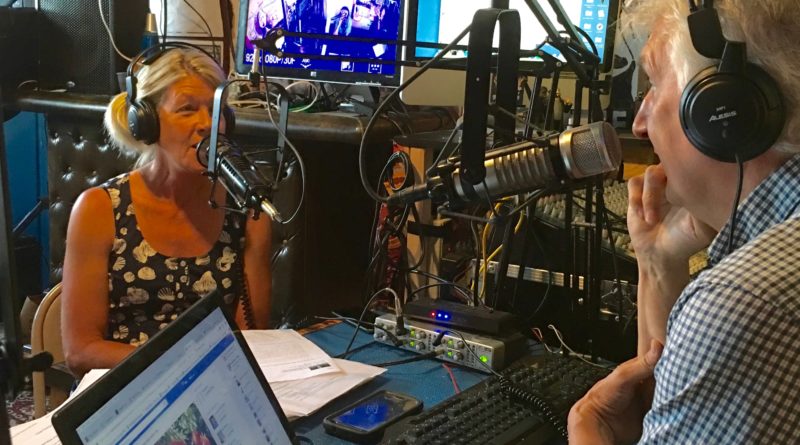January 14, 2017 – Secrets of Selecting Seeds
![]() It’s another abbreviated version of The Mike Nowak Show with Peggy Malecki today. However, The Man has informed us that we get to broadcast for a full two hours on Saturday, January 21. We’ll see. However, this morning we welcome Lisa Hilgenberg, who is the horticulturist at the Regenstein Fruit and Vegetable Garden at the Chicago Botanic Garden, back to the program. Her mission: to teach us as much as she can in about twenty minutes about which seed catalogs to order and how to get those little guys started–and when!
It’s another abbreviated version of The Mike Nowak Show with Peggy Malecki today. However, The Man has informed us that we get to broadcast for a full two hours on Saturday, January 21. We’ll see. However, this morning we welcome Lisa Hilgenberg, who is the horticulturist at the Regenstein Fruit and Vegetable Garden at the Chicago Botanic Garden, back to the program. Her mission: to teach us as much as she can in about twenty minutes about which seed catalogs to order and how to get those little guys started–and when!
It’s all in the seed
It was July of 2016 when we last talked to Lisa Hilgenberg, Horticulturist at the Regenstein Fruit and Vegetable Garden at the Chicago Botanic Garden. Not to put too fine a point on it, but she’s in charge of 50,000 vegetable plants, which people pay to see. No pressure at all.
And if you’re going to grow that many plants, you probably have to know something about seeds, too, since I assume (and I could be wrong) that most of those plants are grown from seed. So Peggy and I are bringing her back to the show today because choosing seeds is one of the very first things that gardeners do each year, and it is one of the most important.
Not only that, but if all goes well, I will be posting a series of podcasts and other information on www.mikenowak.net under the heading “Mike’s Gardening Basics” or something like that. (You’re welcome to send your own suggestions.) The idea is start now, in January, and work through the entire year, posting the very basic information about growing plants, indoors and out. I’m not saying that this will be the bible of what to do in the garden; I’m just trying to give our listeners a head start when it comes to growing things.
But back to Lisa. She recently penned several articles for the current issue of Natural Awakenings Chicago. In the article Demystifying Seed Catalogs, she writes that
The best seed catalogs will help decipher a gardener’s questions and help plot, measure and sort out the seed math needed to get started on a vegetable garden. Most seed is available in organic and non-organic options, with the latter usually the least expensive. Good catalogs provide keys to help decipher the icons (vegetable-resistance codes) in plant descriptions. After all, a seed company’s success is based on the gardener’s success with their products. As our nutritional consciousness rises, the taste and the health benefits of growing our own organic produce is a pursuit worthy of winter afternoons spent planning.
In Best Spring Garden Seeds to Plant, she identifies the best seeds to sow directly into the garden and when it’s warm enough to do that (settle down, folks, we have a couple of months before you even think about it). Let’s not forget that Hilgenberg is in charge of a vegetable garden, so her choices are all vegetables. We’ll handle ornamental plants some other day.
Her top choices are radishes, ,beets, Swiss chard, carrots, spinach, lettuce and spring greens. These are not particularly exotic choices, but they are the kinds of edibles that most people love. With the exception of radishes, I’m on board with those choices. On the other hand, because radishes are so easy to grow and so pretty, they’re hard to resist…with the exception of eating them. But that’s just me.
And once you’ve decided what you want to plant, you need to know where to find those seeds. That’s where Recommended Seed Suppliers comes in. I have discovered, over the years, that list of seed suppliers is remarkably consistent from gardener to gardener–at least the ones I’ve interviewed. And that has to do with the quality of the seed. Here are the companies that Lisa recommends:
Baker Creek Heirloom Seeds – 417-924-8887 (fax)
The Cooks’ Garden (Burpee) – 800-457-9703
High Mowing Organic Seeds – 866-735-4454
Johnny’s Selected Seeds – 877-564-6697
Pinetree Garden Seeds and Accessories – 207-926-3400
Seed Savers Exchange – 563-382-5990
Friend of the show Mr. Brown Thumb has appeared a number of times on the program to talk about seed starting. Last year, he wrote a piece called Easy Plants to Grow from Seed. You might find it useful. And several years ago he wrote a piece for Treehugger called 10 Best Heirloom Seed Companies as Selected by Readers. That list overlaps quite a bit with Lisa’s, though you might discover something slightly different that you like.
Mother Earth News also did a story called Best Vegetable Seed Companies, where they list their top 15 sustainable seed companies.
I suspect that you now have enough information to keep you busy for awhile. Stay tuned for more in the series in how to grow things.

